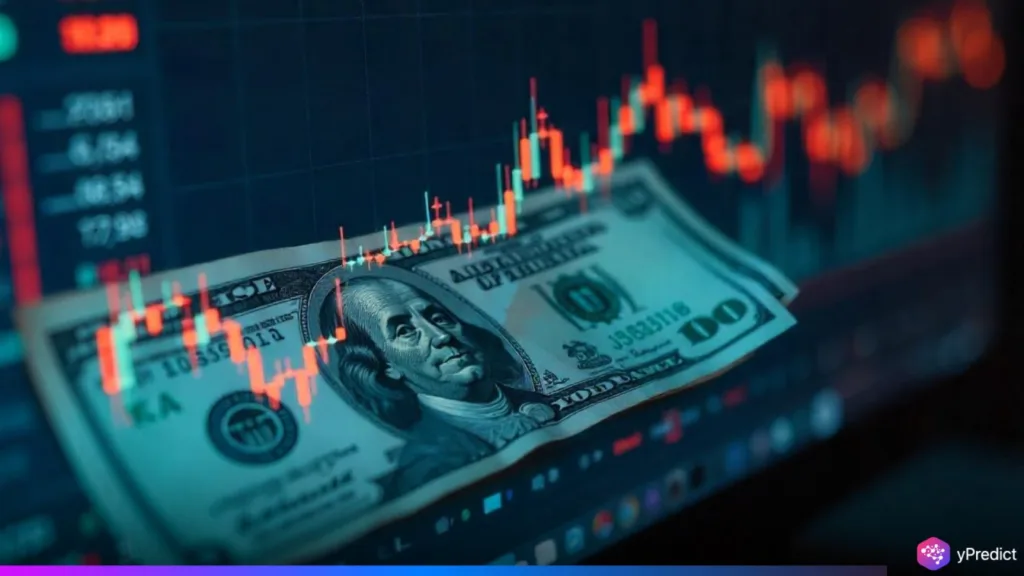
Dollar and global shares fall as escalating trade tensions between the United States and China reignited investor fears and triggered sharp sell-offs across major financial markets. The latest market turmoil follows U.S. President Donald Trump’s announcement to double tariffs on steel and aluminum imports, sparking fears of a renewed trade war.
In response, the U.S. dollar weakened against major currencies, while equity markets in Asia, Europe, and North America posted significant losses. As concerns over inflation, disrupted supply chains, and slower economic growth mount, investors are retreating to safe-haven assets, driving up market volatility and uncertainty across global financial systems.
Tariffs Shake Markets as Dollar and Global Shares Fall
Global markets began the week under pressure as rising trade disputes between the United States and China, monetary policy uncertainty, and geopolitical worries weighed on investor confidence. Reuters reports that Asian and European shares fell after President Trump unexpectedly announced late Friday that he will hike tariffs on imported steel and aluminum to 50% beginning June 4.
The move caused a selloff in shares of multinational steel companies and garnered strong criticism from European Union authorities. The consequences spread to currency and commodities markets, where safe-haven assets such as the yen, Swiss franc, and gold regained popularity.
Treasury Secretary Scott Bessent said Sunday that President Trump planned to speak with Chinese President Xi Jinping to address the dispute over critical minerals. However, Beijing swiftly rejected the U.S. allegations, clouding prospects for any immediate talks. The renewed friction unsettled markets, with Europe’s STOXX 600 dropping 0.5% and bond prices slipping, even as the euro strengthened amid a move away from the dollar.
Strategists remarked that the administration’s shifting attitude on trade looks unconcerned about the market volatility it produces. Derek Halpenny of MUFG said,
The flip-flopping on trade policy looks set to continue, and it appears the uncertainty this creates does not bother President Trump at all. That is likely to give investors the reason to renew selling of the U.S. dollar.
Dollar Reacts to Policy Uncertainty
The dollar index, which measures the currency’s performance versus six major counterparts, fell 0.6% to 98.77, bringing its year-to-date losses to 9%. Additionally, the dollar lost ground against its major counterparts. It fell 0.8% against the yen to below 143, declined 0.6% versus the Swiss franc, and weakened 0.2% against the Canadian dollar. The euro climbed to $1.1423, its highest level since late April.
Despite a court verdict that determined Trump had exceeded his power with broad-based tariffs, White House officials insisted that alternate legal paths exist to carry out such actions.
The dollar has now posted five consecutive monthly losses, mirroring the pattern seen during the pandemic-induced volatility of 2020. Morgan Stanley forecasts continued weakness into next year as growth slows and the Fed potentially cuts rates. Meanwhile, the yen strengthened for the third straight day.
Global Stocks Decline Amid Investor Caution
Investors are now looking to see if Trump will impose the 50% tariff hike on Wednesday or back down from the proposal, as he has done previously. As uncertainty lingers, analysts expect continued market pressure if the dollar and global shares fall again after Wednesday’s decision. Meanwhile, risk-aversion has taken hold. U.S. market futures matched the sentiment, with the S&P 500 down 0.5% and the Nasdaq down 0.7%. The dips follow robust gains in May, when the S&P 500 surged 6.2% and the Nasdaq jumped 9.6%, boosted by hopes that final tariff levels would be lower than previously anticipated.
Additionally, Asian stocks declined as Japanese and Australian markets opened lower, mirroring U.S. futures losses amid rising tariff fears. Investors shifted to safe havens, pushing gold up 2% to $3,353 per ounce. Brent crude gained 2.4% to $64.25 after OPEC+ announced a smaller-than-expected July output hike.
Conclusion
As markets brace for further policy announcements and potential retaliation from trade partners like China and the EU, volatility is likely to remain elevated. Analysts warn that without a diplomatic de-escalation, global trade could suffer a multi-quarter setback, particularly impacting emerging economies and export-reliant sectors.







